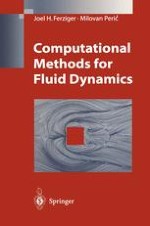1996 | OriginalPaper | Chapter
Methods for Unsteady Problems
Authors : Prof. Dr. Joel H. Ferziger, Prof. Dr. Milovan Perić
Published in: Computational Methods for Fluid Dynamics
Publisher: Springer Berlin Heidelberg
Included in: Professional Book Archive
Activate our intelligent search to find suitable subject content or patents.
Select sections of text to find matching patents with Artificial Intelligence. powered by
Select sections of text to find additional relevant content using AI-assisted search. powered by
In computing unsteady flows, we have a fourth coordinate direction to consider: time. Just as with the space coordinates, time must be discretized. We can consider the time “grid” in either the finite difference spirit, as discrete points in time, or in a finite volume view as “time volumes”. The major difference between the space and time coordinates lies in the direction of influence: whereas a force at any space location may (in elliptic problems) influence the flow anywhere else, forcing at a given instant will affect the flow only in the future — there is no backward influence. Unsteady flows are, therefore, parabolic-like in time. This means that no conditions can be imposed on the solution (except at the boundaries) at any time after the initiation of the calculation, which has a strong influence on the choice of solution strategy. To be faithful to the nature of time, essentially all solution methods advance in time in a step-by-step or “marching” manner. These methods are very similar to ones applied to initial value problems for ordinary differential equations (ODEs) so we shall give a brief review of such methods in the next section.
